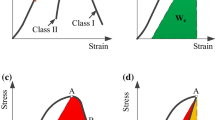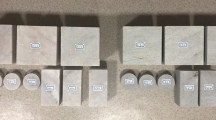Abstract
Acoustic emissions were used to investigate the evolution of damage and strain localization in Castlegate sandstone specimens subjected to true triaxial states of stress, where the intermediate principal stress ranged from equal to minimum compression to equal to maximum compression. Three failure modes were observed: shear band formation at low mean stresses, compaction localization at intermediate stresses, and no localization at high mean stresses. For shear bands, the onset of localization consistently occurred prior to peak stress, while compaction localization initiated at the beginning of a stress plateau. The band angle (defined as the angle between the band normal and the maximum compression direction) determined by fitting a plane through the localized acoustic emission events corresponded well with the shear band angle expressed on the specimen jacket. As expected, the band angle decreased with increasing mean stress. The theoretically predicted dependence of band angle on deviatoric stress state was not confirmed; however, data scatter due to natural variations in material could obscure such a trend. Each failure mode displayed a unique acoustic emission rate response; therefore, this rate response alone can be used to determine the failure mode and the onset of localization in Castlegate sandstone.
















Similar content being viewed by others
References
Andò E, Hall S, Viggiani G, Desrues J, Bésuelle P (2012) Grain-scale experimental investigation of localised deformation in sand: a discrete particle tracking approach. Acta Geotech 7:1–13. doi:10.1007/s11440-011-0151-6
Baud P, Klein E, Wong T (2004) Compaction localization in porous sandstones: spatial evolution of damage and acoustic emission activity. J Struct Geol 26:603–624
Baud P, Vajdova V, Wong T (2006) Shear-enhanced compaction and strain localization: inelastic deformation and constitutive modeling of four porous sandstones. J Geophys Res 111:B12401
Besuelle P (2001) Compacting and dilating shear bands in porous rock: theoretical and experimental conditions. J Geophys Res 106:13435–13442
Bésuelle P, Desrues J, Raynaud S (2000) Experimental characterisation of the localisation phenomenon inside a Vosges sandstone in a triaxial cell. Int J Rock Mech Min Sci 37:1223–1237
Challa V, Issen KA (2004) Conditions for compaction band formation in porous rock using a two-yield surface model. J Eng Mech 130:1089–1097
Charalampidou E, Hall SA, Stanchits S, Lewis H, Viggiani G (2011) Characterization of shear and compaction bands in porous sandstone deformed under triaxial compression. Tectonophysics 503:8–17
Desrues J, Chambon R, Mokni M, Mazerolle F (1996) Void ratio evolution inside shear bands in triaxial sand specimens studied by computed tomography. Geotechnique 46:529–546
DiGiovanni, AA, Fredrich JT, Holcomb DJ, Olsson WA (2007) Microscale damage evolution in compacting sandstone. Geological Society, Special Publications, London, vol 289, pp 89–103
Fortin, J, Stanchits S, Dresen G, and Gueguen Y (2009) Acoustic emissions monitoring during inelastic deformation of porous sandstone: comparison of three modes of deformation. Pure Appl Geophys 166. doi:10.1007/s00024-009-0479-0
Fortin J, Stanchits S, Dresen G, Gueguen Y (2006) Acoustic emission and velocities associated with the formation of compaction bands in sandstone. J Geophys Res 111:B10203. doi:10.1029/2005JB003854
Frenshan P, Jelen J (1987) Displacement of heavy oil visualized by CAT scan. J Can Petro Tech 26:605
Haimson B (2003) Borehole breakouts in Berea sandstone reveal a new fracture mechanism. Pure App Geophys 160:813–831
Issen KA, Dewers TA, Holcomb, DJ (2008) Investigation of strain localization in Castlegate Sandstone. 8th international workshop on bifurcations and degradations in geomaterials (IWBDG), Lake Louise, Alberta, Canada
Holcomb DJ, Gettemy GL, Olsson WA (2006) Investigation of the compaction localization process in porous sandstone using acoustic emission locations and focal mechanisms. 15th US national congress of theoretical and applied mechanics, Boulder, CO
Ingraham, MD, Issen KA, Holcomb DJ (2012) Compactant features observed under true triaxial states of stress. 46th US rock mechanics symposium, paper 367
Ingraham MD, Issen KA, Holcomb DJ (2013) Response of Castlegate sandstone to true triaxial states of stress. J Geophys Res Solid Earth 118:536–552. doi:10.1002/jgrb.50084
Issen KA, Challa V (2008) Influence of the intermediate principal stress on the strain localization mode in porous sandstone. J Geophys Res 113:B02103
Issen KA, Rudnicki JW (2000) Conditions for compaction bands in porous rock. J Geophys Res 105:21529–21536
Issen KA, Rudnicki JW (2001) Theory of compaction bands in porous rock. Phys Chem Earth Sci 26:95–100
Johns RA, Steude JS, Castanier LM, Roberts PV (1993) Nondestructive measurements of fracture aperture in crystalline rock cores using X-ray computed tomography. J Geophys Res 98:1889–1900. doi:10.1029/92JB02298
Klein E, Baud P, Reuschlé T, Wong T-f (2001) Mechanical behaviour and failure mode of Bentheim sandstone under triaxial compression. Phys Chem Earth Part A Solid Earth Geodesy 26:21–25
Lei X, Kusunose K, Rao MVMS, Nishizawa O, Satoh T (2000) Quasi-static fault growth and cracking in homogeneous brittle rock under triaxial compression using acoustic emission monitoring. J Geophys Res 105:6127. doi:10.1029/1999JB900385
Lockner D (1993) The role of acoustic emission in the study of rock fracture. Int J Rock Mech Min Sci Geomech Abstr 30:883–899. doi:10.1016/0148-9062(93)90041-B
Lockner DA, Byerlee JD, Kuksenko V, Ponomarev A, Sidorin A (1991) Chapter 1 observations of quasistatic fault growth from acoustic emissions. International Geophysics Academic Press, London, pp 3–31
MATLAB version 7.10.0 (2010) Natick. The MathWorks Inc., Massachusetts
Olsson WA (1999) Theoretical and experimental investigation of compaction bands in porous rocks. J Geophys Res 104:7219–7228
Olsson WA, Holcomb DJ (2000) Compaction localization in porous rock. Geophys Res Lett 27:3537–3540
Rudnicki, JW, Olsson WA (1998) Reexamination of fault angles predicted by shear localization theory. Int J Rock Mech Min Sci 35: Paper No. 88
Rudnicki JW, Rice JR (1975) Conditions for the localization of deformation in pressure-sensitive dilatant materials. J Mech Phys Solids 23:371–394
Schubnel, A, Thompson B, Fortin J, Gueguen Y, Young RP (2007) Pore pressure induced rupture and aftershocks on intact and fractured sandstone in the laboratory. Geophys Res Lett 34. doi:10.1029/2007GL031076
Stanchits, S, Vinciguerra S, Dresen G (2006) Ultrasonic velocities, acoustic emission characteristics and crack damage of basalt and granite. Rock DMG Fluid Trans (Part 1): 975–994. doi:10.1007/3-7643-7712-7_4
Stanchits S, Fortin J, Gueguen Y, Dresen G (2009) Initiation and propagation of compaction bands in dry and wet Bentheim sandstone. Pure Appl Geophys 166. doi:10.1007/s00024-009-0478-1
Tagliaferri F, Waller J, Andò E, Hall S, Viggiani G, Bésuelle P, DeJong J (2011) Observing strain localisation processes in bio-cemented sand using X-ray imaging. Gran Mat 13:247–250. doi:10.1007/s10035-011-0257-4
Tembe S, Vajdova V, Wong T-f, Zhu W (2006) Initiation and propagation of strain localization in circumferentially notched samples of two porous sandstones. J Geophys Res 111:B02409. doi:10.1029/2005JB003611
Tembe S, Baud P, Wong T-f (2008) Stress conditions for the propagation of discrete compaction bands in porous sandstone. J Geophys Res 113:B09409
Townend E, Thompson BD, Benson PM, Meredith PG, Baud P, Young RP (2008) Imaging compaction band propagation in Diemelstadt sandstone using acoustic emission locations. Geophys Res Lett 35:L15301. doi:10.1029/2008GL034723
Vajdova V, Wong T-f (2003) Incremental propagation of discrete compaction bands: acoustic emission and microstructural observations on circumferentially notched samples of Bentheim. Geophys Res Lett 30:1775. doi:10.1029/2003GL017750
Wang SY, Huang YB, Pereira V, Gryte CC (1985) Application of computed tomography to oil recovery from porous media. App Optics 24:4021–4027
Wawersik WR, Carlson LW, Holcomb DJ, Williams RJ (1997) New methods for true-triaxial rock testing. Int J Rock Mech Min Sci 34:330–330e14
Wong T-f (1990) Mechanical compaction and the brittle-ductile transition in porous sandstones. In: Knipe RJ, Rutter EH (eds) Deformation mechanisms, rheology and tectonics. Geological Society, London, pp 111–122
Wong T, David C, Zhu W (1997) The transition from brittle faulting to cataclastic flow in porous sandstones: mechanical deformation. J Geophys Res 102:3009–3025. doi:10.1029/96JB03281
Zang A, Wagner FC, Dresen G (1996) Acoustic emission, microstructure, and damage model of dry and wet sandstone stressed to failure. J Geophys Res 101:17507–17521
Acknowledgments
The authors thank Steve Bauer, David Bronowski, Scott Broome, the late Robert Hardy, John Hofer, and Wolfgang Wawersik for their stimulating conversations, advice, and assistance in conducting the experiments. We also thank Thomas Pfeifle, Thomas Dewers, and the Sandia National Laboratories Geomechanics department for their support and access to their laboratory facilities. Financial support was provided by the National Science Foundation, award EAR-0711346, to Clarkson University. Finally, we thank two anonymous reviewers and the Editor handling this submission for their insightful comments, which resulted in an improved manuscript.
Author information
Authors and Affiliations
Corresponding author
Rights and permissions
About this article
Cite this article
Ingraham, M.D., Issen, K.A. & Holcomb, D.J. Use of acoustic emissions to investigate localization in high-porosity sandstone subjected to true triaxial stresses. Acta Geotech. 8, 645–663 (2013). https://doi.org/10.1007/s11440-013-0275-y
Received:
Accepted:
Published:
Issue Date:
DOI: https://doi.org/10.1007/s11440-013-0275-y




